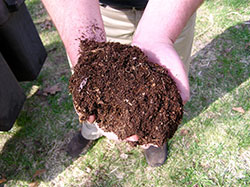Adapted by Jane Rozum, Douglas County Extension, from the CO-Horts blog originally authored by Kurt Jones, Chaffee County Extension Director.

As our gardening season comes to an end, rather than throwing away plant waste, many gardeners will compost those materials and help to improve their soils for future years.
Composting is an accelerated way to reduce the volume of organic wastes and return them to the soil to benefit growing plants. Organic matter improves the drainage and aeration of clay soil. Compost can be thought of as a separator that “shoulders apart” tightly packed clay particles to allow air and water to enter. Compost also helps sandy soil hold water and nutrients. Compost holds moisture like a sponge and releases nutrients slowly into plants as needed. It also increases the activity of earthworms and other natural soil organisms that are beneficial to plant growth. Compost should not be thought of as a fertilizer. The amount of nutrients in compost is limited, but the improved soil characteristics make the addition of compost into garden or flower beds worth the effort.
Choose your composting site carefully. Partial shading avoids the baking and drying in summer but provides some solar heating to start the composting process. A site protected from drying winds prevents too much moisture loss. Choose a site that is close to where the composted materials will be used, but not highly visible or one that interferes with yard activities.
Structures are not necessary for composting, but prevent wind and marauding animals from spreading plant waste. Structures are also more aesthetically pleasing for your family and neighbors. The structure should be large enough to handle the amount of yard waste you are likely to produce, yet small enough to be able to mix the contents and remove the composted materials. A suggested minimum size is 36 inches by 36 inches by 36 inches high. Some better insulated wood or plastic structures can hold sufficient heat at smaller volumes.
The breakdown of organic yard wastes is a biological process dependent on microorganism activity. Like most living things, these microbes require favorable temperatures, moisture, oxygen, and nutrients.Plant digesting microbes operate in a temperature range of 70 degrees F to 140 degrees F. Well-managed compost breaks down rapidly at internal temperatures between 120 degrees to 130 degrees F. During the winter months, microbial activity is slowed, thereby slowing the composting process.
Probably the toughest balance to maintain in Colorado’s climate is the moisture and oxygen balance. Moisture must be added to compost piles to maintain optimal microbial activity. Too much moisture, however, will limit the amount of oxygen causing the compost to have a foul odor and to not break down. The best description of the proper moisture level is “moist” or “damp” but not “soggy.” The entire mass of plant waste should be moistened uniformly to the point where only a few drops of water can be squeezed from a fistful of plant material.
The microbes that break down plants use the plants for food. Nitrogen is the most important nutrient. A shortage of nitrogen in the composting materials greatly slows the process. Green plant materials fortunately contain a high percentage of nitrogen. Other sources of nitrogen include animal waste, granular fertilizer, or bloodmeal. Carbon is also an important nutrient in the composting process. Sources of carbon include woody materials, fallen leaves, shredded newspaper and animal bedding.
Smaller particle sizes greatly enhance the composting process. Plant pieces of ½ to 1-1/2 inches are ideal, allowing sufficient surface area for microbial activity. These different plant materials should be layered in the composting structure in 6-8 inch layers. Use equal parts of green plant materials (nitrogen source) and dry plant materials (carbon source). Some soil can be added to the compost pile to inoculate the pile, but research has shown that too much soil can hinder the composting process. “Soilless” composting is an effective means of breaking down plant materials.
For more information see the following PlantTalk scripts:
- Planttalk #1612: Composting: Fall leaves
- Planttalk #1613: Composting: Making
- Planttalk #1615: Composting: What can be composted
For more information, view the following YouTube videos:
For more information see the following fact sheet:



